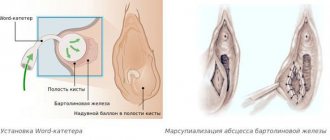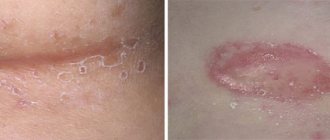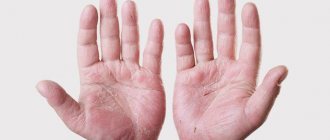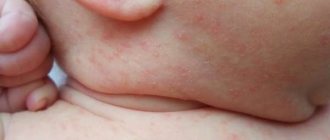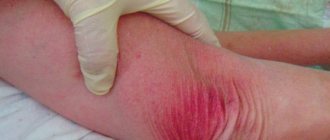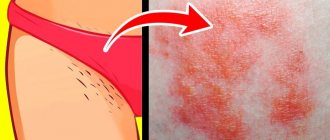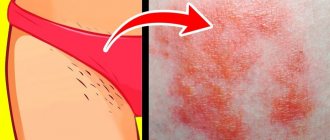Diaper rash is an inflammatory disease that occurs with prolonged contact with moisture, friction (intertrigo), and allergic reactions. The lesions are localized in skin folds - interdigital spaces, armpits, groin area, intergluteal cavity. Skin irritation is fraught with septic (infectious) inflammation. Diaper rash in a child's groin is diagnosed by a pediatric dermatologist or pediatrician. The severity of symptoms varies from mild irritation and redness to weeping with superficial cracks and erosions.
What is it - diaper rash
Diaper rash in a child's groin is a common dermatological problem that occurs mainly in infancy. In infants, the epidermis is thinner than in adults. Due to the looseness of the protective layer, favorable conditions are created for the proliferation of pathogenic microorganisms - protozoa, bacteria, viruses, fungi.
Intertrigo is a local inflammation of the skin caused by constant friction and contact with irritating substances. Even a slight mechanical impact on tissue during bathing or swaddling can lead to irritation. Children's skin is prone to damage and maceration (impregnation with moisture), swelling.
What does diaper rash look like in the groin area:
- skin folds take on a red tint;
- without treatment, cracks and bleeding ulcers form in the groin;
- the focus of inflammation is covered with a dark brown coating;
- Diaper rash has a strong putrid odor.
Due to insufficient ventilation of the skin in the groin, conditions arise for the proliferation of bacteria. In case of septic inflammation of skin folds, infectious intertrigo is diagnosed.
Symptoms
It should be noted that after minor signs of irritation appear, diaper rash in newborns quickly progresses if measures are not taken to eliminate the provoking factors. A severe form in a child, in which treatment under the supervision of a doctor is required, can develop very quickly (in 1-2 days).
What does diaper rash look like in newborns?
If the diaper does not absorb urine enough, diaper rash appears in the groin of newborn boys, since the skin is constantly wet. In children with sensitive skin or prone to allergic reactions, irritation appears on the bottom, perineum and genital area. The likelihood of its occurrence increases if the diaper is rarely changed. This is due to the fact that when overfilled, the absorbent properties of the diaper are reduced. Redness under the arms develops when the child sweats and the delicate skin rubs against rough parts of clothing. Foci of redness have clear boundaries, and the color intensity can range from pink to bright red. Lack of care and treatment causes progression of the process - the development of superficial ulcers. It is assumed that if redness persists for three days and does not respond to treatment, the skin is infected with Candida fungi or bacterial flora.
If we consider this process in stages, then at the beginning (first stage) the irritability of the skin increases - slight and faint local redness appears.
Photo of erythematous dermatitis
In the second stage, if irritating factors are not eliminated, the skin appears bright red (inflammation), and erosions and cracks appear on the surface of the skin. Microorganisms found in feces infect the baby's irritated skin. When a microbial infection occurs, the surface becomes wet (weeping), bright red, and against the background of hyperemia, microcracks, ulcers and pustules appear. The elements spread quickly, forming large areas of skin damage.
The lesion has clear boundaries, swelling . The eroded surface may contain purulent (with a bacterial infection) or white cheesy (with a fungal infection) coating. A pustular rash may appear around diaper rash due to a bacterial infection. Such complications are accompanied by itching, pain and burning. In some cases, the temperature rises, the child is restless, cries, does not sleep, and refuses to eat. Complicated diaper rash is severe and long lasting.
Reasons for appearance
Excess moisture is the key cause of diaper rash in the groin area in children.
Other reasons why children's skin is susceptible to irritation include:
- underdevelopment of the hydrolipid mantle of the skin;
- excessive sweating;
- tendency to allergies;
- weak local immunity;
- looseness of the epidermis.
Inflammation of the skin folds of the groin is provoked by many external factors. Their exclusion prevents dermatological problems, pyoderma and sepsis in children.
Excreta
Foci of skin inflammation in the groin occur in areas of irritation from urine and feces. Baby feces contain many biochemicals:
- amines;
- skatole;
- ammonia;
- lipase;
- hydrogen sulfide;
- thiols, etc.
Waste products in prolonged contact with the groin cause irritation. Diaper rash often appears precisely when complementary foods from fruit purees and juices begin to be introduced. This is evidence that the child’s body cannot yet cope with the new food.
Improper use of diapers
In 45-50% of cases of diaper rash in the groin of newborn boys, it is associated with improper use of diapers. They consist of synthetic materials that retain moisture. With infrequent changes, urine stops being absorbed into the diapers. Because of this, the skin is constantly in contact with irritating substances. Many pediatricians generally recommend abandoning disposable diapers in favor of cotton onesies and diapers.
Improper care and bathing
Redness and itching in the intimate area are one of the signs of improper care of children's skin. Tissue hyperemia in the groin is often associated with:
- using washcloths with a rough surface;
- careless washing of the child;
- insufficient drying of the skin.
After water procedures, you need to wait until the skin folds dry completely. It is also necessary to use hygroscopic powders that prevent diaper rash.
Friction
Possible causes of irritation also include prolonged skin contact with:
- tight clothes;
- diapers;
- snakes and seams on clothes.
Constant friction leads to irritation of the soft tissues in the groin, swelling and inflammation. If diaper rash is not treated promptly, bacterial infections often occur.
Allergies to care products and food
Allergies to food and children's cosmetics are one of the key reasons for redness of the skin folds in the groin. Low-quality powders and creams contain irritating components - alcohols, parabens, preservatives, etc. They provoke an allergic reaction and inflammation.
The mother can determine whether the baby has this disease on her own, since the skin has a characteristic diaper rash appearance, and take appropriate measures. If a child has severe diaper rash in the groin, treatment should be prescribed by a doctor.
Diaper rash often occurs in infants when they are transferred to artificial feeding or when complementary foods are introduced.
Overheat
Severe diaper rash is associated with excessive wrapping of the child, which provokes excessive sweating. Friction of wet skin in the groin area leads to irritation, swelling and inflammation. To prevent diaper rash, it is recommended to dress newborns in light clothing made of breathable fabrics - linen, cotton.
Skin infections
The risk group includes infants who suffer from skin pathologies:
- impetigo;
- seborrheic eczema;
- diaper dermatitis;
- candidiasis;
- allergic dermatosis.
Depending on the provoking factors, dermatologists distinguish allergic, yeast, seborrheic, bacterial and other types of diaper rash in the groin.
Pathogenesis
The pathogenesis of diaper rash is associated with the influence of a number of damaging, predisposing and provoking factors. The main role is played by a combination of chemical (stool enzymes, urine products), mechanical (friction) and microbial (from feces and urine) damaging factors against the background of impaired skin care and a decrease in its protective function.
Prolonged contact with moisture increases the moisture content of the skin, which increases friction against the diaper (moisturized skin is easily damaged by friction). Enzymes (enzymes) of feces irritate the skin, cause loosening of the epidermis and increase its permeability. Urine enhances the aggressive action of fecal enzymes. The incidence of diaper rash is lower in infants who receive breast milk because the intestines of infants who drink cow's milk contain urease-producing bacteria. An increase in skin moisture and a shift in pH to the alkaline side contribute to the proliferation of Candida albicans and bacteria, so inflammation “under the diaper” intensifies. The activity of fecal enzymes increases with diarrhea, so diaper dermatitis is very common in babies with bowel movements.
Differences in degree of damage
The degree of damage to the skin in the groin is determined by the severity of symptoms. In dermatology and pediatrics, the following stages of diaper rash are distinguished:
- First (initial). With mild diaper rash in a child, the integrity of the epidermis is not compromised. Mild hyperemia and soft tissue irritation are noted. With adequate treatment, symptoms disappear after 2-3 days.
- Second. The skin folds in the groin become bright red. Erosion and cracks occur in places of greatest friction. The skin becomes rough and small pustules form on it.
- Third. With third degree diaper rash, the skin turns purple. Bleeding ulcers form with detachment of the epidermis. Due to severe pain, the child becomes tearful and sleeps poorly.
For diaper rash of degrees 2 and 3, it is necessary to show the baby to a dermatologist or pediatrician. Ulcers in the groin indicate an infectious inflammation caused by staphylococci or streptococci. If treatment is delayed, local infection spreads quickly. If the provoking factors are not eliminated, healthy tissues become involved in inflammation. When infection enters the bloodstream, there is a risk of sepsis, a deadly complication.
How and with what to treat diaper rash
Features of therapy are determined by the degree of irritation of the skin folds in the groin. To find out how to get rid of diaper rash, contact your pediatrician.
You should consult your doctor to determine what is right for your child. In order for the treatment of diaper rash to be successful, the cause of its occurrence is first eliminated.
In the absence of bacterial infections, symptomatic agents are prescribed - antiseptics, wound healing, anti-inflammatory ointments, powders, etc. Ulcers in the groin are treated with antimicrobial gels and liniments.
Baths
Treatment of stage 1 and 2 diaper rash is carried out using alternative medicine. Warm baths with decoctions of anti-inflammatory herbs relieve irritation and accelerate the regeneration of the epidermis in the groin. For these purposes the following are used:
- Oak bark;
- pharmaceutical chamomile;
- series;
- eucalyptus leaves;
- Birch buds.
4 tbsp. l. raw materials are poured into 1 liter of water and boiled for 5 minutes. The strained broth is mixed with bath water. Also, to combat diaper rash, use a weak solution of potassium permanganate. The powder is added to warm water, the color of which should become pale pink. The duration of the procedure is 5-7 minutes. Baths are done daily until symptoms disappear.
Ointments
Pharmacy ointments help remove diaper rash in a newborn in 3-7 days. It is recommended to smear the groin area after water procedures up to 2 times a day. The preparations are applied exclusively to dry skin in a thin layer.
The best ointments and creams for diaper rash:
- Bepanten – stimulates skin regeneration in the groin, relieves irritation;
- Nystatin ointment - destroys infectious diaper rash caused by fungi of the genus Candida;
- D-Panthenol – accelerates the restoration of mucous membranes and skin during irritation;
- Zinc ointment - dries out weeping, prevents infectious inflammation;
- Desitin – softens and dries soft tissues with diaper dermatitis.
Some ointments are not used for purulent-necrotic changes in the groin area. Therefore, before using them, consult a pediatric dermatologist.
Powders
Hygroscopic powder is the best remedy for diaper rash. Used to treat and prevent groin irritation in children. The drug contains mineral talc, absorbents and anti-inflammatory additives. They prevent moisture accumulation in skin folds and excessive skin friction.
To remove diaper rash in newborns, powders are used:
- Kapitoshka;
- Bübchen;
- Johnson;
- Karapuz;
- Lander.
Powders are used no more than 2 times a day after hygiene procedures. Pediatricians do not advise treating the skin too often. This is fraught with blockage of the sweat and sebaceous glands, which leads to purulent rashes.
Oils
Natural oils with antiseptic properties soften the skin, reduce sweating and irritation. Used for the prevention and treatment of stage 1 diaper rash. Children's cosmetics based on almond, peach and coconut oils have pronounced healing properties.
To cope with diaper rash, use BoNaRo, Johnson's baby. The oil is used to treat irritated skin in the groin area 2 times a day. It is recommended to use cosmetics after water procedures no more than 2 times a day. It is not advisable to put diapers or synthetic clothing on the child within an hour after treatment.
For fungal inflammation of the skin, sea buckthorn oil is used. It contains vitamins, flavonoids and acids that have antioxidant and anti-inflammatory properties. Foci of inflammation are treated 2-3 times a day.
Other methods
Diaper rash in a child’s groin should be treated in accordance with the recommendations of a pediatric dermatologist. Usually, special means are not used to eliminate symptoms. But in case of septic inflammation of tissues, the doctor prescribes antimicrobial or antibacterial drugs - Baneocin, Erythromycin, Titanium, Syntomycin ointments.
The danger of diaper rash is the rapid transition from one stage to another. With inactivity, slight redness can give way to severe irritation within a few hours. Heat and high humidity worsen the prognosis.
For diaper rash of degrees 2 and 3, physiotherapeutic procedures are recommended. Ultraviolet irradiation of the groin prevents the penetration of infection into the damaged epidermis. If the disease is caused by diathesis or diaper dermatitis, desensitizing (antiallergic) drugs are prescribed - Lokoid, Posterisan, Hydrocortisone, etc.
What not to do
In the hope of speeding up recovery, parents often make mistakes that only worsen the child’s condition. To prevent complications in your baby, you need to avoid:
- Treatment of ulcerations with starch. Upon contact with damaged groin tissue, the powder forms crusts. They only increase friction in the skin folds, causing the epidermis to become even more injured.
- Oil wipes. Do not use oil-impregnated wipes to wipe the groin area. This is fraught with even greater irritation and swelling.
- Frequent bathing. Water procedures are performed no more than 2-3 times a day. To prevent diaper rash, dry the skin thoroughly with a towel or paper napkins.
If there is redness in the groin, the child should be shown to the pediatrician. The doctor will determine the cause of the irritation and prescribe adequate treatment.
Prevention
The immaturity of the baby's skin requires careful care, which is the prevention of diaper rash and all kinds of skin rashes. Proper skin care includes:
- the use of modern products for child skin care (children's cosmetics include liquid soap, baby soap with neutral pH, cream, lotion, oil);
- Frequently washing the child after defecation and urination with thorough drying of the skin;
- eliminating friction on the skin of diapers, clothes and nappies;
- correct choice of diapers by size (weight);
- frequent diaper changes - after each feeding, before bedtime, during the night, after a night's sleep;
- use of diaper cream (Bubchen, Mustela1 2 3, Bepantol);
- refusal of baby powder;
- use of intimate hygiene wipes (Pampers, Huggies, Johnson's Baby), which clean, moisturize and maintain pH balance.
How to prevent skin irritation
To prevent skin irritation in an infant girl or boy, you need to follow the rules of hygienic care:
- diapers are changed every 3 hours and after each bowel movement;
- after changing the diaper, the groin area is wiped with wet wipes and treated with powder;
- air baths are provided at least 3-4 times a day;
- for infants, choose loose underwear made from natural materials;
- clothes are washed only with children's hypoallergenic powders.
When introducing complementary foods, it is necessary to monitor the reaction of the child's skin to new products. If diaper rash is detected, the child is taken to the pediatrician. Timely therapy prevents even greater tissue damage and complications.
Causes
The reasons are:
- violations of hygienic care (poor skin care, refusal to bathe, untimely change of diapers);
- mechanical and chemical effects on the skin;
- increased skin moisture and lack of aeration;
- low quality diapers and clothes;
- background conditions ( atypical dermatitis , seborrheic dermatitis ).
Contribute to the development of diaper rash:
- age-related skin characteristics;
- change of feeding (switching to artificial);
- taking antibiotics ;
- intestinal disorders;
- teething;
- excessive wrapping;
- high temperature in the room;
- inappropriate diaper size (small and tight-fitting).

